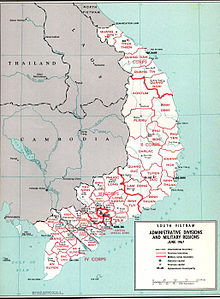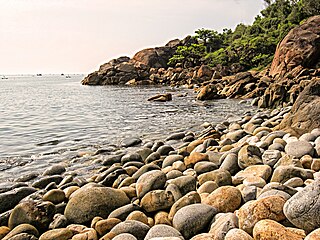
Bình Định is a northern coastal province in the South Central Coast region, the Central of Vietnam. It borders Quảng Ngãi to the north, Phú Yên to the south, Gia Lai to the west and the East Sea to the east.

Major General Nguyễn Văn Hiếu was a general in the South Vietnamese Army of the Republic of Vietnam (ARVN). As a child he lived in Shanghai. He later emigrated with his ethnic Vietnamese parents to Saigon when the Chinese Communist Party took over China in 1949. He attended Aurore University in Shanghai, China. In 1950, he attended the Vietnamese Military Academy, graduating second in his class in 1951. In 1963, he graduated from Command and General Staff College, at Fort Leavenworth, Kansas.
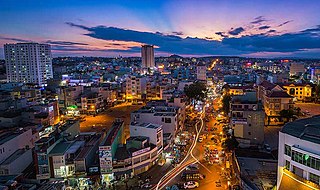
Pleiku is a city in central Vietnam, located in the Central Highlands region. It is the capital of the Gia Lai Province. Many years ago, it was inhabited primarily by the Bahnar and Jarai ethnic groups, sometimes known as the Montagnards or Degar, although now it is inhabited primarily by the Kinh ethnic group. The city is the centre of the urban district of Pleiku which covers an area of 261 km².
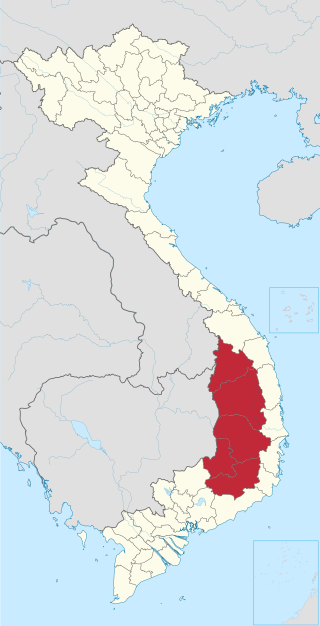
The Central Highlands, South Central Highlands, Western Highlands or Midland Highlands is a region located in the south central part of Vietnam. It contains the provinces of Đắk Lắk, Đắk Nông, Gia Lai, Kon Tum, and Lâm Đồng.

Gia Lai is a northern mountainous province in the Central Highlands region, the Central of Vietnam. It borders Kon Tum in the north, Quảng Ngãi in the northeast, Bình Định in the east, Phú Yên in the southeast, Đắk Lắk in the south and Ratanakiri of Cambodia in the west.

In Vietnam, South Central Coast and South Central Region are two terms which can refer to the same region or two regions that do not correspond to each other. South Central Coast consists of the independent municipality of Đà Nẵng and seven other provinces, which means South Central Coast doesn't include Central Highlands. Nevertheless, the term "South Central Region" can also be used to include Central Highlands as it is part of southern part of Central Vietnam.
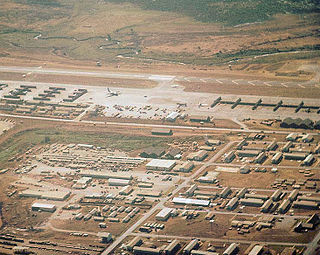
Pleiku Air Base is a former air force base in Vietnam. It was established by the Republic of Vietnam Air Force (RVNAF) in 1962 at an undeveloped airstrip, and was used by the United States Air Force during the Vietnam War in the II Corps Tactical Zone of South Vietnam. It was captured by the People's Army of Vietnam (PAVN) in March 1975 and was abandoned for many years. Today, the facility has just redeveloped as Pleiku Airport。
Jarai is a Malayo-Polynesian language spoken by the Jarai people of Vietnam and Cambodia. The speakers of Jarai number approximately 530,000, not including other possible Jarai communities in countries other than Vietnam and Cambodia such as United States of America. They are the largest of the upland ethnic groups of Vietnam's Central Highlands known as Degar or Montagnards, and 25 per cent of the population in the Cambodian province of Ratanakiri.

The 1975 spring offensive, officially known as the general offensive and uprising of spring 1975, was the final North Vietnamese campaign in the Vietnam War that led to the capitulation of Republic of Vietnam. After the initial success capturing Phước Long Province, the North Vietnamese leadership increased the scope of the People's Army of Vietnam's (PAVN) offensive and captured and held the key Central Highlands city of Buôn Ma Thuột between 10 and 18 March. These operations were intended to be preparatory to launching a general offensive in 1976.

The Battle of Ban Me Thuot was a decisive battle of the Vietnam War which led to the complete destruction of South Vietnam's II Corps Tactical Zone. The battle was part of a larger North Vietnamese military operation known as Campaign 275 to capture the Tay Nguyen region, known in the West as the Vietnamese Central Highlands.
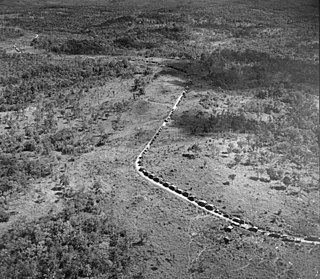
The Battle of Mang Yang Pass was one of the last battles of the First Indochina War which took place on 24 June 1954. The battle was one of the bloodiest defeats of the French Union forces, along with the battle of Dien Bien Phu shortly beforehand.

The siege of Plei Me was the beginning phase of the first major confrontation between soldiers of the North Vietnamese People's Army of Vietnam (PAVN) and the U.S. Army during the Vietnam War. The lifting of the siege by South Vietnamese forces and American air power was followed by the pursuit of the retreating North Vietnamese from 28 October until 12 November, setting the stage for the Battle of Ia Drang.

Major General Phạm Văn Phú was an officer in the Army of the Republic of Vietnam.

The II Corps was a corps of the Army of the Republic of Vietnam (ARVN), the army of the nation state of South Vietnam that existed from 1955 to 1975. It was one of four corps in the ARVN, and it oversaw the central highlands region, north of the capital Saigon. Its corps headquarters was in the mountain town of Pleiku.

The 23rd Division of the Army of the Republic of Vietnam (ARVN)—the army of the nation state of South Vietnam that existed from 1955 to 1975—was part of the II Corps that oversaw the Central Highlands.

The 22nd Division of the Army of the Republic of Vietnam (ARVN) was part of the II Corps that oversaw the region of the Central Highlands north of the capital Saigon. The 22nd Division was based in Ba Gi near the south central coast.
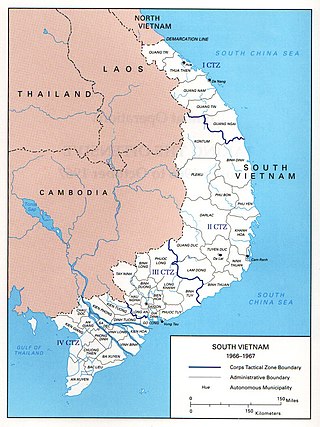
The 3rd Armored Cavalry Squadron a battalion-sized unit of the Army of the Republic of Vietnam (ARVN), the South Vietnamese army. It was part of II Corps that oversaw the twelve provinces of the central highlands; corps headquarters being in the mountain town of Pleiku. The 3rd Armored Cav was organized on January 1, 1954.
Phú Phong is a town in south central Vietnam. It is the capital of Tây Sơn District in Bình Định Province.

National Route 19 runs across Vietnam roughly in line with the 14th parallel north. The route includes two segments: National Route 19 begins at Qui Nhơn and ends just short of the Vietnam-Cambodia border, while National Route 19B begins on the Qui Nhơn peninsula and joins Route 1 east of Phu Cat Airport.
The War of the flags was a phase of fighting throughout South Vietnam lasting from 23 January to 3 February 1973 as the forces of North and South Vietnam each sought to maximize the territory under their control before the ceasefire in place agreed by the Paris Peace Accords came into effect on 27 January 1973. The fighting continued past the ceasefire date and into early February. South Vietnamese forces made greater territorial gains and inflicted significant losses on the North Vietnamese forces.
